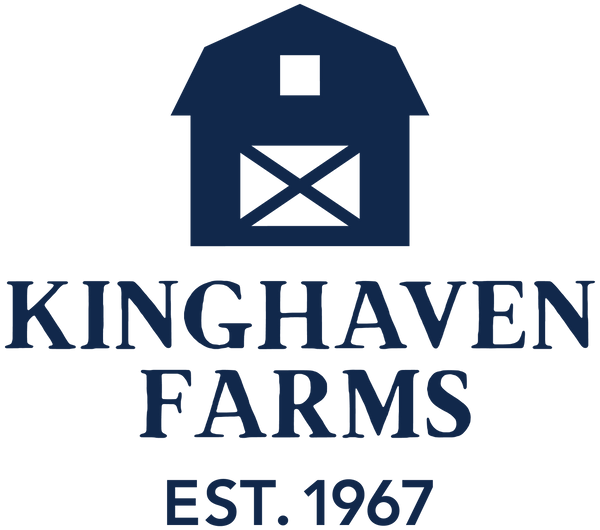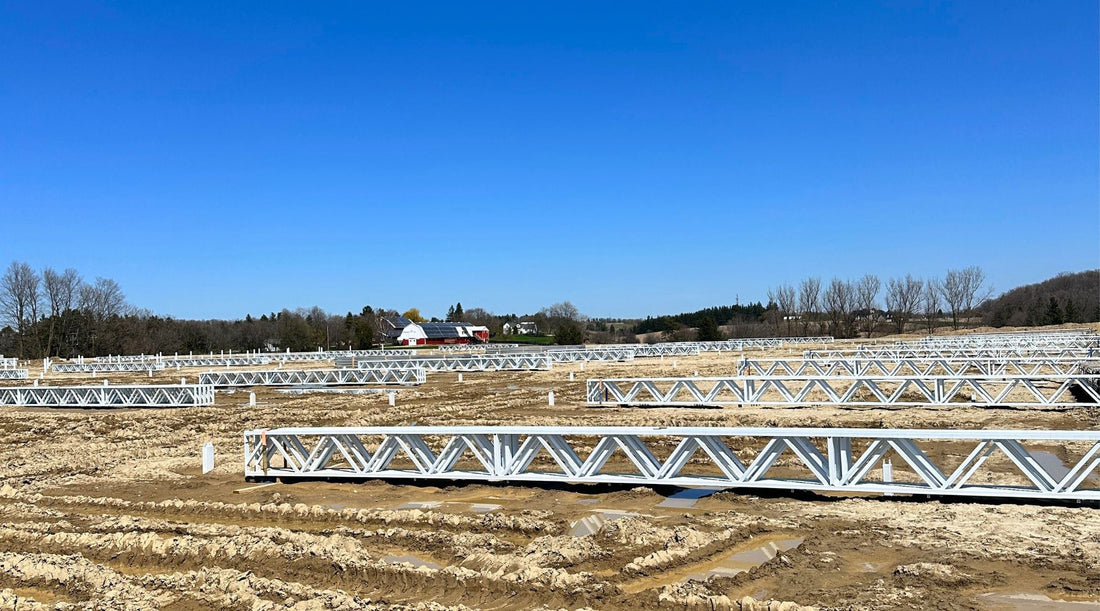Image: Kinghaven Farms
We have a lettuce problem in Ontario. We love our salads, but how we get our greens leaves a lot to be desired. Most of the lettuce Ontarians buy is grown in the western United States, which means that by the time it gets to you it’s both old (and often slimy) and incredibly bad for the environment — yes, even the organic kind.
Here at Kinghaven Farms, we knew there had to be a better way. That’s why we’re on a mission to get Ontarians amazing tasting, pesticide and herbicide-free, sustainably grown, leafy greens at a price that won’t blow their budget. Here’s how we’re changing what you put on your plate, one salad at a time.
Why is lettuce so darn expensive?
If you’re a lettuce lover you likely already know that the price of lettuce has skyrocketed recently. Statistics Canada reports that lettuce prices jumped by more than 30% between December 2021 and December 2022. The most recent data from June 2023 shows another 6% increase.
While it’s true that inflation has driven up grocery prices significantly, it’s not the only factor behind the sharp increase in lettuce prices.
Canada imports more than half a billion dollars of lettuce a year, almost all of it from the United States — more specifically, California. Since most of the lettuce we consume comes from just one place, what happens there has a huge effect on what we eat here. And things in California aren’t looking good.
The disastrous effects of climate change are coming for us all. But for the lettuce farmers of Salinas Valley, — California’s so-called salad bowl — they’re already here. California saw an end to three years of drought last year with a deluge of rain. However, the state’s aging infrastructure isn’t optimized to collect all that water, leaving farmers there without adequate hedges against future dry spells.
These extreme swings between drought and flooding have hit California farmers hard, leaving them few choices but to pass on their increased costs to consumers. Weather predictions aren’t clear yet, but both drought and flooding are distinct possibilities for the region in the years to come.
The effects of climate change aren’t limited to water issues — it often goes hand-in-hand with pests as well. In the Salinas valley this has been no exception as the dry weather has resulted in an explosion of thrips, a tiny insect that feeds on lettuce and other veggies. Besides causing spotting on the crops they eat, thrips have also spread a virus called INSV which has ravaged California lettuce crops.
As you may have guessed by its nickname, “the salad bowl,” Salinas Valley is populated by many farms growing leafy greens. So when a pathogen that infects lettuce is introduced, it’s hard to stop. It can spread from plant to plant, row to row, and field to field quickly, decimating large swaths of produce. As a result, some growers lost more than 80% of their harvest in fall 2022.
With these factors stacked against California growers, it’s little wonder that lettuce is on the verge of becoming a luxury food for many.
How does growing lettuce affect the environment?
According to Scientific American, growing lettuce currently produces more greenhouse gases than manufacturing bacon. It’s confusing, right? We’ve been taught for years now that choosing a plant-based diet instead of a meat-heavy one is better for both our bodies and the planet. To a certain degree that’s true. However, where your food comes from matters just as much as how it’s produced.
Lettuce, it turns out, is difficult to grow, harvest, and transport — especially when it’s coming from thousands of kilometers away. For starters, traditional lettuce growing methods use tonnes of water. Because lettuce has shallow roots, it needs constant watering to grow. Traditional farming methods use irrigation to supply this consistent moisture, but in large fields, much of this water is lost to evaporation.
While it could definitely do better in the water-wasting department, this is by no means the most resource-intensive part of traditional lettuce-farming. A major reason for the high emissions associated with the crop is the amount of lettuce that producers throw out before it even reaches the consumer.
To ensure they have enough time to sell their leafy greens to consumers while they still look good, big retailers typically want a minimum of 10-11 days left on a package's best before date when they receive it. But California lettuce takes a minimum of four to five days to travel before it hits grocery store shelves in Ontario.
According to Scientific American, growing lettuce currently produces more greenhouse gases than manufacturing bacon.
This poses a big problem for producers who don't want to pay to transport lettuce to retailers that won’t accept it upon delivery. To avoid this issue, producers often end up dumping fresh, perfectly good lettuce before it’s even loaded onto the truck. Even if it’s two weeks from its best before date.
Since many farms know this is simply part of doing business, they overplant — by an estimated 10%. In other words, they expect to throw out one in ten perfectly good lettuces they grow, because it takes so long to get to the consumer. And, because it’s already packaged before it’s thrown out, it doesn’t make it to the compost pile. Instead, it heads right to the dump.
The rest of the lettuce may make it to your plate — or at least your local supermarket — but the emissions that go into getting it there are significant. Add in the emissions created to transport that California lettuce to your local greengrocer and the pesticides used to spray the crops and that side salad on your plate turns into a recipe for climate disaster.
How Kinghaven Farms will change what Canadians put on their plate
No shade to all those Californian farmers. We know how hard they work, and with so many factors out of their control, they have no choice but to pass on their increased production costs to consumers.
But we’ve reached a tipping point when it comes to the climate, and lettuce that travels thousands of kilometres before it reaches your plate isn’t good for anyone. Buying local food must be one of the pieces of creating a more environmentally sustainable food system.
At Kinghaven, we realized that we were uniquely positioned to contribute to a local and more sustainable food system in a few ways.
Most of Canada is too cold to grow crops year round. Greenhouses have helped to work around this to a certain degree, however, the technology associated with them has long limited their output.
We decided to move greenhouse technology forward in a meaningful way by investing in a highly automated system that operates with low emissions and harnesses solar energy. This approach insulates us from the unpredictability of energy costs and aligns with our commitment to deliver consistent value to our customers through sustainable practices.

What’s more, unlike California lettuce, our greens don’t have a 4,300 KM trek to get on your plate. Instead, our family-run farm is a mere 30 minutes from Toronto. Our close proximity to the city and its food terminals that distribute vegetables to the entire province, means our lettuce can hit the shelves significantly sooner.
Because our lettuce doesn’t travel thousands of kilometres to get to the store, it tastes better and it’s better for you — full of the vitamins and minerals your body needs. In contrast, the nutritional value of California lettuce degrades with each day that goes by between picking and consumption — not to mention what it does to taste.
Besides being local and pesticide-free, herbicide-free and fungicide-free, our lettuce will also create significantly fewer emissions than southern California greens. However, our emissions reductions aren’t just realized in the form of reduced shipping travel and energy consumption.
Indoor production also means we don’t have to worry about many of the pests that afflict outdoor crops. Our facilities are being built with environmental controls that will completely eliminate the need for traditional agrochemicals like insecticides or pesticides.
As an added bonus, our automated system will standardize growth and quality. We anticipate that this will result in close to 100% of our leafy greens being market ready.
Sustainability is one of our guiding principles here at Kinghaven. That’s why we’ve put so much effort into renaturalizing areas of the farm and building massive solar installations, and we see our greenhouse project as a natural extension of that vision.
We’re deepening this commitment and working to change the way Canadians get their veggies by offering crisp, fresh, salad greens that are better for you and the environment. Follow along for updates to our greenhouse project and follow our socials to be one of the first to enjoy our non-GMO, sustainable, and freshly grown Canadian produce.
In the meantime, please visit our website to satisfy your sweet cravings with some of our delicious and sustainably-harvested raw honey.


